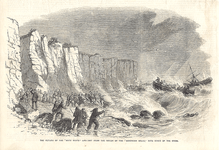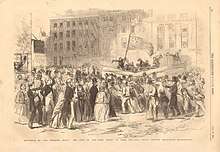Northern Belle
.jpg)
The Northern Belle was an American transatlantic ship which ran aground near Thanet, England, on 5 January 1857.[1] No lives on her were lost, thanks to heroic rescue efforts, in blizzard conditions. However, another ship sank, en route to the scene, the Margate lugger "Victory" which was lost along with her crew.[2]
The Belle built in 1853, under the ownership of J. P. Whitney and Co. of New Orleans,[3][4] was a new vessel only three years old, her common routes were New Orleans to Liverpool and Le Havre, carrying wheat on the outbound run. A barque of 1,150 tons burden[4][5] with a crew of 23, she was on a voyage from New York to London,[6] with a cargo of wheat, flour, and linseed cake,[7] when as a result of an unusually heavy gale had to put into Kingsgate, Kent. She anchored 3/4 of a mile from the shore,[8] however by 6 am she was riding heavily, the sea occasionally breaking completely over her. The storm was so ferocious that the main and mizzen masts were cut away by the crew at 6.30am. The Margate lugger "Victory"'', along with the Ocean, and the Eclipse attempted a rescue and possible salvage.[9] The Victory was lost along with her crew at 11.30 am. The storm raged all day without respite. The storm would not allow the local lifeboats to launch. The Belle parted from her anchors at midnight, and was driven onto the rocks beneath nearby cliffs, at Foreness Point.[10] All rescue attempts that day had been unsuccessful. The crew had lashed themselves to the one remaining mast, and were, to shocked onlookers surprise, spotted from the beach at dawn. Two lifeboats, the Mary White and the Culmer White made three trips to rescue them, despite the imminent peril they were in, from the boiling surf. The lifeboats and crew were from Broadstairs and Margate. Their Mary White had to be hauled and dragged two miles over fields of snow by man and horse before it could be launched the next day from a place that would allow it.[11][9][12][6] Captain Tate[13] and all his crew were thus saved; thanks to the Mary White in particular.

On 15 January 1857 (Thursday) the Illustrated Times of London advertise that they will print 5 engravings of the tragedy and portraits of the crew on Saturday.[14]
It was reported on 22 January in a letter to the Standard in London, that the ship and cargo were still on the reef, in good condition, and were salvageable. It was hoped to get her off the reef with comparatively little damage.[5]
News of the disaster was broadcast world-wide, as far as the Sydney Morning Herald who picked up the story from the New York Times.[15] A benefit by "gentlemen amateurs" was held at the St James's Theatre, in London, on 7 February; one of the pieces they performed was the comedy" Still waters run deep".[16]
On the 23 February 1857 3,340 barrels of damaged American flour, a part of the cargo, was auctioned off at the "New Corn Exchange Coffee House", Mark Lane, London.[17]
On the 2 March, another 450 barrels of damaged American flour, and 20 barrels damaged Linseed cake was auctioned at the "New Corn Exchange Coffee House".[18]

The Times on 5 March, reports the vessel is a shipping hazard, and all her cargo has been salvaged except forty to fifty logs of Mahogany. Only two barrels of dynamite would be required to destroy the wreck.[19] The Liverpool Echo pointed out in 9 March 1857 that the wreck in foggy weather was an obstacle to navigation, "A few days ago a ship had a narrow escape by striking it."[20]
April 1857, the U.S. president Franklin Pierce had 21 silver medals struck and issued for the rescuers an award of £270 sterling for sharing amongst them; proportionate to the risks taken, of between £10 to £30 each.[6]
The London Morning Chronicle of 9 October 1857 reported that after 9 months the wreck was to be raised as she was a shipping hazard, chains had been fitted with a view of floating her with the aid of buoys at the next spring tides. Some Whitstable people had bought the hull for £260.[21][22]
Reports on 21 November 1857 were, that after nearly 10 months in the water, efforts made by her salvors to raise her, proved unsuccessful, despite employing four pontoons and successfully raising the stern out of the water, one of the chains around the hull broke, aborting the attempt...[23] Her masts disappeared from view in early December, and a green buoy marked wreck had to be put in place 10 fathoms eastward from the stern.[24]
In June 1858 Canterbury Town Council, put on display a piece of the wreck taken from the recently raised hull, which was completely riddled with Teredo worm.[25]
A Margate beer shop in 1858 is named the "Northern Belle".[26]

Poetry
The tragedy will inspire many books, almost immediately, poetry. February 1857 Charles Mackay wrote a poem "Northern Belle - a tribute to the brave", in March 1857.[27] Edwin Arnold wrote "Northern Belle" of the incident with the proceeds to go to fund for the bereaved.[28]
References
- ↑ The Nautical Magazine and Naval Chronicle for 1857. Cambridge University Press. Mar 28, 2013. Retrieved 5 October 2017.
- ↑ "A Boatman's Tales:". Holbourn genealogical index. Retrieved 5 October 2017.
- ↑ "Ships - Havre". The Times Picayune, New Orleans, Louisiana. 25 Jan 1854. Retrieved 15 June 2018.
- 1 2 "Sailings for United States". Liverpool Echo. 2 March 1855. Retrieved 15 June 2018.
- 1 2 Baldwin, Astley Henry (23 January 1857). "The Wreck of the Northern Belle". The Standard, London. Retrieved 15 June 2018.
- 1 2 3 Dallas, G. M. (1 May 1857). "The Northern Belle". Daily News. Retrieved 15 June 2018.
- ↑ "Sales by auction" (28 Feb 1857). The Manchester Guardian.
|access-date=requires|url=(help) - ↑ "The Northern Belle". The Royal Cornwall Gazette, Falmouth Packet, and General Advertiser. 16 January 1857. Retrieved 16 June 2018.
- 1 2 Morris, Susan. "Shipwreck of the 'Northern Belle' and the loss of the 'Victory'". emptageofthanet.co.uk. Retrieved 17 June 2018.
- ↑ Lane, Anthony (2009). Shipwrecks of Kent. Stroud: The History Press. pp. 18, 22. ISBN 978-0-7524-1720-2.
- ↑ Cates, Michael; Chamberlain, Diane. "The Mary White life boat rescuing the crew of the American Ship the Northern Belle". Bonhams. Retrieved 17 June 2018.
- ↑ Lang, John (10 January 1857). "The Loss of the Northern Belle (with timetable of events)". Hampshire Telegraph and Navy Chronicle. Retrieved 15 June 2018.
- ↑ "The late gales - more fatal wrecks". The Era. 11 January 1857. Retrieved 16 June 2018.
- ↑ "Periodicals". Daily News. 15 January 1857.
- ↑ "American Coast Defences". Sydney Morning Herald. New York Times. 1 August 1857. Retrieved 17 June 2018.
- ↑ "Benefit for the Broadstairs and Margat Boatmen". The Examiner. 31 January 1857. Retrieved 16 June 2018.
- ↑ "To be sold by public auction". The Ipswich Journal. 21 Feb 1857. Retrieved 15 June 2018.
- ↑ "Sales by auction". Manchester Guardian 28 Feb 1857. 28 Feb 1857. Retrieved 16 June 2018.
- ↑ An Observer (5 March 1857). "Letter to the Times: The Wreck of the Northern Belle dated 3 March 1857". The Times. p. 10. Retrieved 11 September 2018.
- ↑ "Multum in Parvo". Liverpool Echo. 9 March 1857. Retrieved 15 June 2018.
- ↑ "The Northern Belle". The Morning Chronicle (after "The Southern Gazette"). 9 Oct 1857. Retrieved 15 June 2018.
- ↑ "The Northern Belle". Daily News. South Eastern Gazette. 8 Oct 1857. Retrieved 15 June 2018.
- ↑ "Margate". Dover Telegraph and Cinque Ports General Advertiser. 21 November 1857.
The efforts used to raise the Northern Belle have proved unsuccessful, owing to the breaking of one of the chains which was around the hull ...
- ↑ "Wreck of the Northern Belle". Norwich Mercury. 12 December 1857. p. 3.
Notice hereby given, that the roasts of the American ship, “Northern Belle,” stranded on the rocks off Longnose, having now disappeared, a green buoy, marked with the word wreck
- ↑ "Canterbury Town Council exhibition". Kentish Gazette. 22 June 1858. p. 6.
There were also exhibited a piece of the wreck of the ill fated Northern Belle, lately picked up, and completely riddled with the Teredo Destructor
- ↑ "Licensing at Margate". The Era. 26 Sep 1858. Retrieved 15 June 2018.
- ↑ "New Publications". New York Times. 6 Feb 1857. Retrieved 16 June 2018.
- ↑ "The wreck of the The Era by Edwin Arnold". The Era. 22 March 1857. Retrieved 15 June 2018. (Subscription required (help)).
External links

Coordinates: 51°23′40″N 1°25′40″E / 51.39444°N 1.42778°E